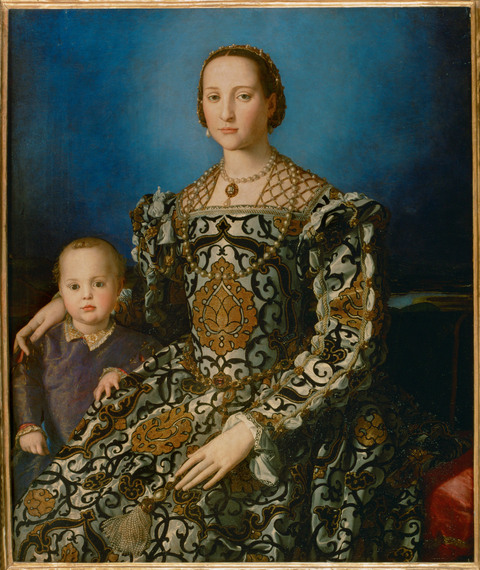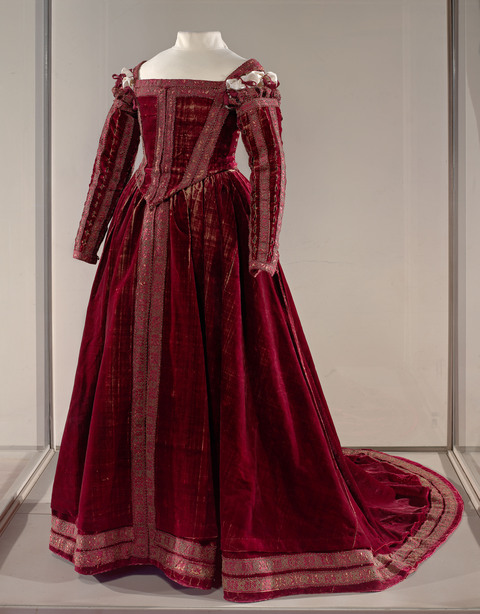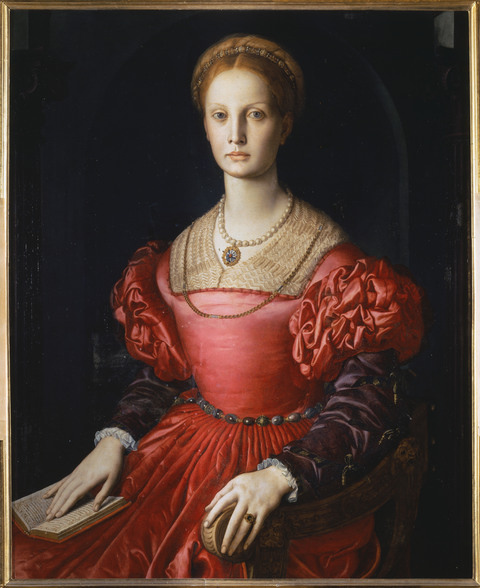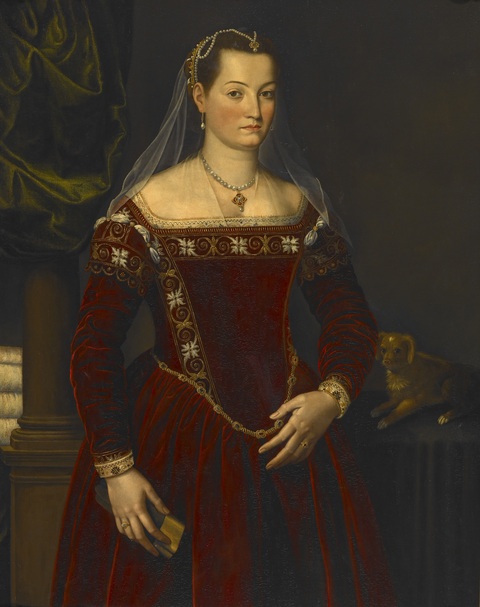Marks, Inscriptions, and Distinguishing Features
None
Entry



Author
Provenance
Ivan N. Podgoursky (1901–1962);
G.H.A. Clowes (1877–1958), Indianapolis, in 1947;30
The Clowes Fund, Indianapolis, from 1958–2000, and on long-term loan to the Indianapolis Museum of Art since 1971 (C10015);
Given to the Indianapolis Museum of Art in 2016.
Exhibitions
Franklin College, Franklin, IN, 1965, Italian, Flemish, and English Painting 1500–1800: From the Clowes Fund Collection, no. 4;
Indianapolis Museum of Art at Newfields, 2019, Life and Legacy: Portraits from the Clowes Collection.
References
Italian, Flemish, and English Painting 1500–1800: From the Clowes Fund Collection, exh. cat. (Franklin College: Franklin, IN, 1965), no. 4, as School of Bronzino (reproduced);
Mark Roskill, “Clowes Collection Catalogue” (unpublished typed manuscript, IMA Clowes Archive, Indianapolis Museum of Art, Indianapolis, IN, 1968);
A. Ian Fraser, A Catalogue of the Clowes Collection (Indianapolis: Indianapolis Museum of Art, 1973), 36–37 (reproduced).
Fiona Beckett, “Conservation in the Clowes Pavilion: Treatment of Jacopo Zucchi’s Portrait of a Lady,” IMA Magazine (May–August 2015): 20–21 (detail reproduced).
Notes
-
In a letter written by Allen W. Clowes to Bertram Newhouse, of Newhouse Galleries, the painter of Portrait of a Lady was misidentified as “Andréa” Bronzino; Mr. Clowes surely intended to type “Agnolo” Bronzino, as the painting is later referenced in correspondence as from the “school of Bronzino.” In a separate letter to Edmund Pillsbury of the Courtauld Institute of Art in London, Mr. Clowes mentions that the painting is from the school of Bronzino, referring to the school of Agnolo Bronzino. Allen W. Clowes to Mr. Bertram Newhouse, 3 October 1966, File 2016.162 (C10015), Clowes Archive, Indianapolis Museum of Art at Newfields; also, see Allen W. Clowes to Edmund Pillsbury, 13 January 1967, File 2016.162 (C10015), Clowes Archive, Indianapolis Museum of Art at Newfields. ↩︎
-
Lorne Campbell, Renaissance Portraits: European Portrait-Painting in the 14th, 15th and 16th Centuries (New Haven: Yale University Press, 1990), 95–96. ↩︎
-
This reattribution was shared orally with Mark Roskill in the summer of 1966. Additionally, a letter composed by Edmund Pillsbury confirms this information. Letter from Edmund Pillsbury to Director of the Clowes Fund, 8 January 1966, File 2016.162 (C10015), Clowes Archive, Indianapolis Museum of Art at Newfields. ↩︎
-
Additionally, other correspondences such as the rendering of the woman’s gown that is similar to the modeling of the drapery in Zucchi’s Amor and Psyche (1589) connect the artist and the Clowes painting. Mark Roskill, “Clowes Collection Catalogue” (unpublished typed manuscript, IMA Clowes Archive, Indianapolis Museum of Art, Indianapolis, IN, 1968); See also, Giovanni Baglione, Le vite de' pittori, scultori, architetti, ed intagliatori, dal pontificato di Gregorio 13. del 1572. sino a ‘tempi di papa Urbano 8. nel 1642. Scritte da Gio. Baglione romano. Con la vita di Salvator Rosa napoletano pittore, e poeta scritta da Gio. Batista Passari, nuovamente aggiunta (Naples, 1733; originally published 1642), 42. ↩︎
-
Mark Roskill, “Clowes Collection Catalogue” (unpublished typed manuscript, IMA Clowes Archive, Indianapolis Museum of Art, Indianapolis, IN, 1968). For a description of Zucchi’s frescoes, which demonstrate his assimilation of Roman Mannerist tendencies, see Edmund Pillsbury, “Jacopo Zucchi in S. Spirito in Sassia,” The Burlington Magazine 116, no. 857 (August 1974): 437. ↩︎
-
Before the 1540s, the petticoat was composed of a separate skirt and a bodice, which served solely as undergarments. Roberta Orsi Landini notes that between 1540 and 1560, the Florentine petticoat altered from an item worn under a gown to a standalone garment that often replaced the dress. This petticoat included a skirt and bodice that were sewn together, oftentimes sleeves that were detachable, and even, on occasion, a train. However, as the author notes, if the petticoat was worn for a formal occasion, it needed to be covered with an outer garment such as zimarra or overgown. For further information on this subject see, Roberta Orsi Landini, “I singoli capi di abbigliamento,” in Moda a Firenze, 1540–1580: Lo stile di Eleonora di Toledo a la sua influenza (Florence: Edizioni Polistampa, 2005), 77, 79, 80. ↩︎
-
Donations of clothing to religious institutions, such as a convent, were an established tradition by 1560. Additionally, the garment’s embroidered decoration was restricted to the bands of trim, which could be detached later and reused on other gowns. Eleonora is known to have offered her tailor suggestions for how such trim on her own gowns could be repurposed. Roberta Orsi Landini, “Gli abiti esistenti,” in Moda a Firenze, 1540–1580: Lo stile di Eleonora di Toledo a la sua influenza (Florence: Edizioni Polistampa, 2005), 71, 74–75; see also Roberta Orsi Landini, “Lo stile di Eleonora,” in Moda a Firenze, 1540–1580: Lo stile di Eleonora di Toledo a la sua influenza (Florence: Edizioni Polistampa, 2005), 27. ↩︎
-
The duchess’s tomb was opened in 1857, and her petticoat has been reconstructed as far as is possible from its remaining fragments by Mary Westerman Bulgarella. No fragments of sleeves were found in the tomb, and the bodice’s shoulders do not feature ribbons with which they would have been attached. Roberta Orsi Landini, “Gli abiti esistenti,” in Moda a Firenze, 1540–1580: Lo stile di Eleonora di Toledo a la sua influenza (Florence: Edizioni Polistampa, 2005), 71. For further information on the garments in which Eleonora di Toledo was entombed, see Moda alla corte dei Medici: Gli abiti restaurati di Cosimo, Eleonora e don Garzia (Florence: Centro Di, 1993) ↩︎
-
Roberta Orsi Landini, “I singoli capi di abbigliamento,” in Moda a Firenze, 1540–1580: Lo stile di Eleonora di Toledo a la sua influenza (Florence: Edizioni Polistampa, 2005), 85. ↩︎
-
Roberta Orsi Landini, “Lo stile di Eleonora di Toledo,” in Moda a Firenze, 1540–1580: Lo stile di Eleonora di Toledo a la sua influenza (Florence: Edizioni Polistampa, 2005), 28. ↩︎
-
Roberta Orsi Landini, “Lo stile di Eleonora di Toledo,” in Moda a Firenze, 1540–1580: Lo stile di Eleonora di Toledo a la sua influenza (Florence: Edizioni Polistampa, 2005), 27. ↩︎
-
Roberta Orsi Landini, “Gli abiti esistenti,” in Moda a Firenze, 1540–1580: Lo stile di Eleonora di Toledo a la sua influenza (Florence: Edizioni Polistampa, 2005), 27. ↩︎
-
Fiona Beckett, then Clowes Conservator of Paintings, also detected the presence of lead-tin yellow I in the jewelry. This pigment was a common staple in a Renaissance artist’s palette. See Technical Examination Report. ↩︎
-
Cesare Vecellio, “Habiti Antichi Et Moderni,” in Cesare Vecellio, Margaret F. Rosenthal, and Ann Rosalind Jones, The Clothing of the Renaissance World: Europe, Asia, Africa, the Americas; Cesare Vecellio’s Habiti Antichi et Moderni (London: Thames & Hudson, 2008), 228–229 (Vecellio), 280–281 (Rosenthal). ↩︎
-
Roberta Orsi Landini, “Lo stile di Eleonora di Toledo,” in Moda a Firenze, 1540–1580: Lo stile di Eleonora di Toledo a la sua influenza (Florence: Edizioni Polistampa, 2005), 31. ↩︎
-
Roberta Orsi Landini, “Lo stile di Eleonora di Toledo,” in Moda a Firenze, 1540–1580: Lo stile di Eleonora di Toledo a la sua influenza (Florence: Edizioni Polistampa, 2005), 30. ↩︎
-
The definition for “zimarra” was taken in part from, Roberta Orsi Landini, “Lo stile di Eleonora di Toledo,” in Moda a Firenze, 1540–1580: Lo stile di Eleonora di Toledo a la sua influenza (Florence: Edizioni Polistampa, 2005), 30.252. ↩︎
-
See Vincenzo Fedeli al Senato Veneto nel 1561, quoted in Sergio Bertelli, Le corti italiane del Rinascimento (Milan: A. Mondadori, 1985), 24. ↩︎
-
This accoutrement was worn even by girls as young as age six; and hence, it appears to have been an essential component of a well-appointed wardrobe. Roberta Orsi Landini, “I singoli capi di abbigliamento,” in Moda a Firenze, 1540–1580: Lo stile di Eleonora di Toledo a la sua influenza (Florence: Edizioni Polistampa, 2005), 166. ↩︎
-
For an example of this type of setting, see Agnolo Bronzino’s Portrait of a Young Girl with a Book (Galleria degli Uffizi, Florence), which is today speculated to portray Giulia, the daughter of Duke Alessandro de’ Medici, who after her father’s assassination was raised by Cosimo’s mother Maria Salviati and his wife, Eleonora. Additionally, Bronzino’s Eleonora di Toledo (about 1543, Prague, Národní Galerie), displays the duchess’s ring. Antonio Geremicca, II.13, “Portrait of a Young Girl with a Book,” in Bronzino: Artist and Poet at the Court of the Medici, eds. Carlo Falciani and Antonio Natali (Florence: Mandragora: Fondazione Palazzo Strozzi, 2010), 136–137; also see, Roberta Orsi Landini, “Lo stile di Eleonora di Toledo,” in Moda a Firenze, 1540–1580: Lo stile di Eleonora di Toledo a la sua influenza (Florence: Edizioni Polistampa, 2005), 31. ↩︎
-
In this era, gloves were given frequently to women as gifts, and portraits commonly show sitters holding this accessory. Associated symbolically with gallantry, gloves were a perfect gift for significant individuals. Cosimo I and Eleonora gave gloves as tokens of esteem to Pope Julius III, King Phillip II of Spain, Cardinal Ercole Gonzaga, and Ercole II d’Este. The protagonist in Portrait of a Lady carries a pair of brown gloves that have gold-toned gauntlets. These gloves are identical to a pair that belonged to Duchess Eleonora and were carried by her daughter Isabella in the latter’s portrait completed by Allori in about 1555. Gloves were perfumed during this time and could be used to carry small items; in this manner, they served a purpose similar to a women’s girdle. The Florentine sumptuary laws of 1546 regulated the amount of money allowed to be spent on the perfuming of gloves. Roberta Orsi Landini, “I singoli capi di abbigliamento,” in Moda a Firenze, 1540–1580: Lo stile di Eleonora di Toledo a la sua influenza (Florence: Edizioni Polistampa, 2005), 167–168. ↩︎
-
Roberta Orsi Landini, “Lo stile di Eleonora di Toledo,” in Moda a Firenze, 1540–1580: Lo stile di Eleonora di Toledo a la sua influenza (Florence: Edizioni Polistampa, 2005), 37. ↩︎
-
This idea is conveyed at several points in Burckhardt’s text. Jacob Burckhardt, The Civilization of the Renaissance in Italy (1860: English ed. London, Phaidon Press, 1960); Dale Kent separately came to this conclusion in her essay, “Women in Renaissance Florence,” in Virtue and Beauty: Leonardo’s Ginevra de' Benci and Renaissance Portraits of Women, ed. David Alan Brown (Washington, DC: National Gallery of Art, 2001), 26. ↩︎
-
Joanna Woods-Marsden, “Portrait of the Lady, 1430–1520,” in Virtue and Beauty: Leonardo’s Ginevra de' Benci and Renaissance Portraits of Women, ed. David Alan Brown (Washington, DC: National Gallery of Art, 2001), 76. ↩︎
-
Agnolo Bronzino’s Portrait of Laura Battiferri (1555–1560, Florence, Palazzo Vecchio) falls into this latter category and celebrates the sitter’s accomplishments as a poet through the comparison of her distinctive profile to that of the famed Italian poet Dante Alighieri (1265–1321), whose posthumous likeness was recorded in the artist’s earlier Allegorical Portrait of Dante Alighieri (1541, Washington, DC, National Gallery of Art). Raffaele de Giorgio, “IV.8, Portrait of Laura Battiferri,” in Bronzino: Artist and Poet at the Court of the Medici, eds. Carlo Falciani and Antonio Natali (Florence: Mandragora: Fondazione Palazzo Strozzi, 2010), 218. ↩︎
-
Dale Kent, “Women in Renaissance Florence,” in Virtue and Beauty: Leonardo’s Ginevra de' Benci and Renaissance Portraits of Women, ed. David Alan Brown (Washington, DC: National Gallery of Art, 2001), 32. ↩︎
-
Dale Kent, “Women in Renaissance Florence,” in Virtue and Beauty: Leonardo’s Ginevra de' Benci and Renaissance Portraits of Women, ed. David Alan Brown (Washington, DC: National Gallery of Art, 2001), 32. For further information on the death of women in Renaissance Florence due to childbirth and infant mortality, see also Jacqueline Marie Musacchio, The Art and Ritual of Childbirth in Renaissance Italy (New Haven and London: Yale University Press, 1999), 25. ↩︎
-
The duchess’s hairstyle changed slightly after this period. The hair was pulled back with a braid on the top of the head and some curls. Roberta Orsi Landini, “Lo stile di Eleonora di Toledo,” in Moda a Firenze, 1540–1580: Lo stile di Eleonora di Toledo a la sua influenza (Florence: Edizioni Polistampa, 2005), 31–33. ↩︎
-
Roberta Orsi Landini, “I singoli capi di abbigliamento,” in Moda a Firenze, 1540–1580: Lo stile di Eleonora di Toledo a la sua influenza (Florence: Edizioni Polistampa, 2005), 83–84. ↩︎
-
In correspondence relating to Dr. Clowes’s interest in this painting, and its subsequent purchase in spring 1947, Podgoursky does not reveal his source for this painting; see letter from Podgoursky to G.H.A. Clowes, 3 January 1947, and following letters, Correspondence Files, Clowes Registration Archive, Indianapolis Museum of Art at Newfields. ↩︎
